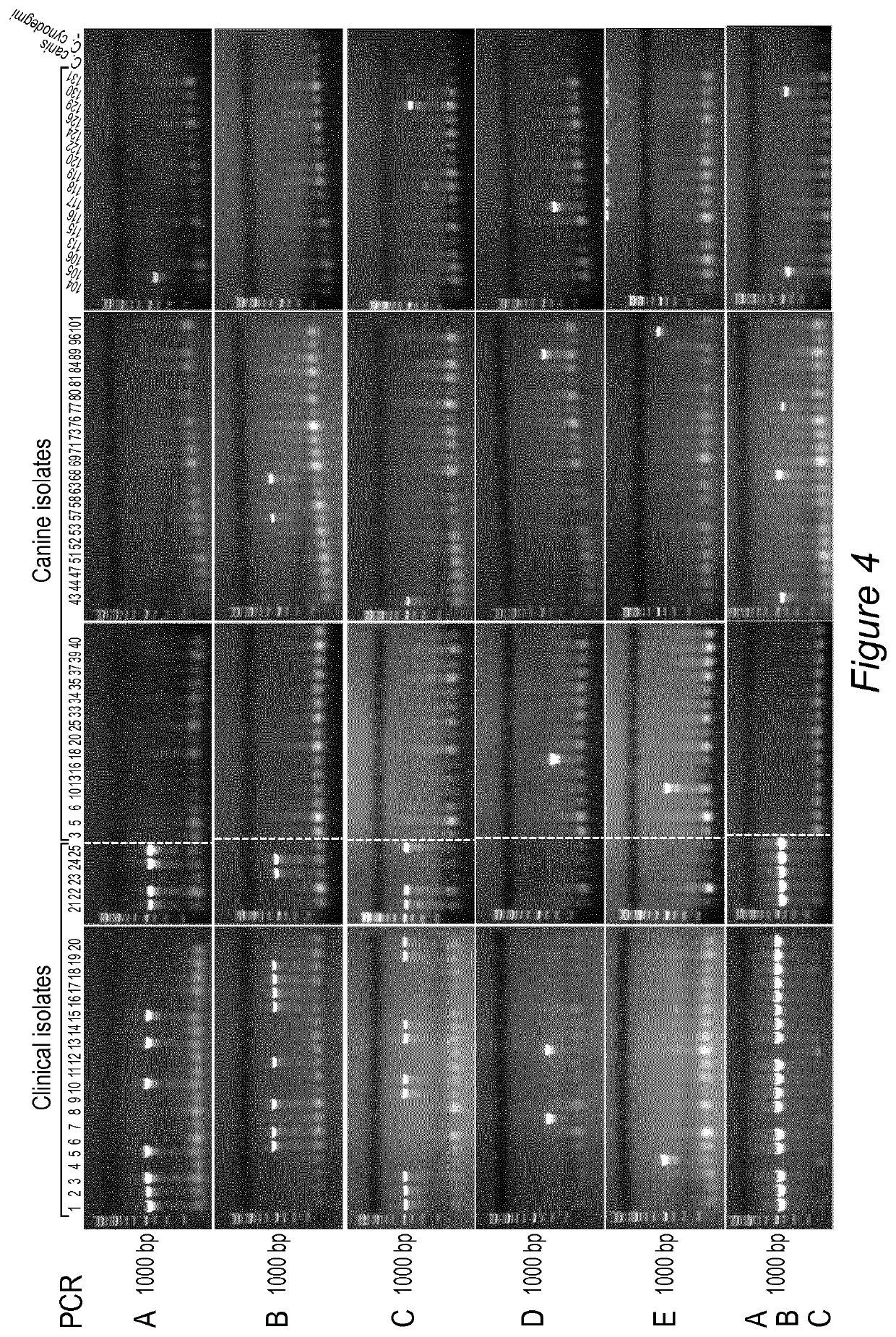Methods for detecting c. canimorsus capsular serotypes in a sample
a technology of c. canimorsus and capsular serotypes, which is applied in the field of in vitro detection methods of potentially pathogenic c. canimorsus strains, can solve the problems of rare but life-threatening infections in humans, c. canimorsus /i>sepsis is bad, and humans often evolve to septic shock
- Summary
- Abstract
- Description
- Claims
- Application Information
AI Technical Summary
Benefits of technology
Problems solved by technology
Method used
Image
Examples
example 2
Serotypes A, B and C are not Linked to a Geographic Area
[0295]The Applicants next assessed whether these capsular serotypes were not linked to the geographical origin of the strains. Among the strains analyzed, ten originated from Belgium, four from Sweden, three from the USA, three from Switzerland, one from France, one from Germany, one from the Netherlands, one from the UK and finally one from Denmark. The 11 strains belonging to the capsular serotype A were isolated in 6 different countries: Sweden (4 / 11; i.e. Cc1, Cc21, Cc24 and Cc25), Belgium (3 / 11; i.e. Cc2, Cc3 and Cc5), USA (1 / 11; i.e. Cc10), the Netherlands (1 / 11, i.e. Cc13), Denmark (1 / 11; i.e. Cc22) and Switzerland (1 / 11; i.e. Cc15). The serotype B strains also originated from three different countries: Belgium (5 / 7; i.e. Cc6, Cc8, Cc16, Cc17 and Cc18), Switzerland (1 / 7; i.e. Cc11) and France (1 / 7; i.e. Cc23). Serotype C strains also came from four different countries (USA (i.e. Cc9), Germany (i.e. Cc14), Belgium (i.e. C...
example 3
t of Capsular Serotype A, B and C Among the Strains Isolated from Human Infections
[0296]The Applicants next assessed the prevalence of the capsular serotypes A to E among a collection of 52 strains isolated from dogs (see Materials and methods section above). To test this collection the Applicants set up an ELISA screening using entire heat-killed bacteria. To this aim, the Applicants needed sera that were specifically recognizing the CPS. For serotype A, the Applicants took the Y1C12-adsorbed anti-Cc5 serum; for serotypes B, C and D, the Applicants adsorbed the crude anti-Cc6, anti-Cc9 and anti-Cc12 sera with Cc6 wbuB, Cc9 wbuB and Cc12 wbtA mutant bacteria respectively. The efficacy of the different adsorptions was validated by immunofluorescence staining and microscopy analysis. While the adsorbed serum recognized the WT strain against which it was raised, it no longer recognized the mutant strain used to adsorb it (FIG. 6). As the Applicants did not succeed to generate the non-c...
example 4
of the Capsular Serotypes A to E by PCR
[0299]The fact that only three capsular serotypes were more represented among clinical isolates than among dog isolates suggests that the presence of these capsules could be linked to a higher virulence. The Applicants thus tried to develop a PCR-based method using different oligonucleotides couples that would allow the identification of the 5 serotypes found among clinical isolates.
[0300]The Applicants thus first compared the loci encoding the capsule and LOS biosynthesis in the seven available genomes of C. canimorsus strains belonging to the five serotypes (Cc5, Cc2, Cc6, Cc11, Cc9, Cc12 and Cc4). Looking for a gene that was specific to serotype A strains (Cc5, Cc2), the Applicants identified an A4galT-like glycosyltransferase gene (Ccan_23210 (SEQ ID NO: 1) and CCAN2_1920004 (SEQ ID NO: 1) in Cc5 and Cc2 respectively) (Renzi F. et al., Scientific Reports, 2016). Two amplimers (called SeroA-fw and SeroA-rev) were designed and our complete C....
PUM
| Property | Measurement | Unit |
|---|---|---|
| Fraction | aaaaa | aaaaa |
| Fraction | aaaaa | aaaaa |
| Fraction | aaaaa | aaaaa |
Abstract
Description
Claims
Application Information
 Login to View More
Login to View More - R&D
- Intellectual Property
- Life Sciences
- Materials
- Tech Scout
- Unparalleled Data Quality
- Higher Quality Content
- 60% Fewer Hallucinations
Browse by: Latest US Patents, China's latest patents, Technical Efficacy Thesaurus, Application Domain, Technology Topic, Popular Technical Reports.
© 2025 PatSnap. All rights reserved.Legal|Privacy policy|Modern Slavery Act Transparency Statement|Sitemap|About US| Contact US: help@patsnap.com



